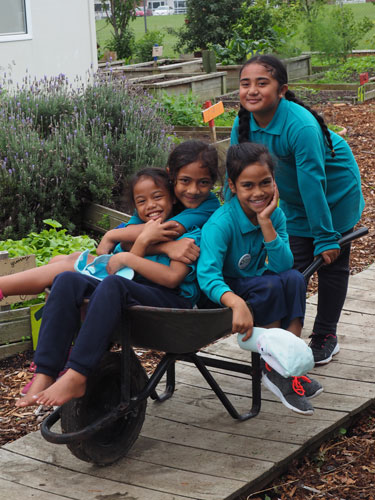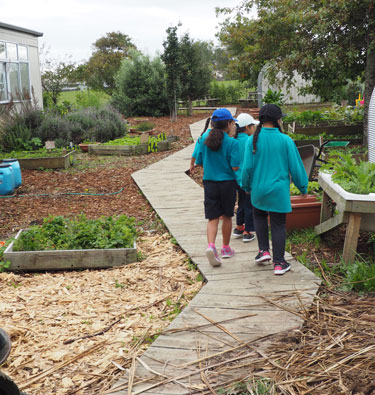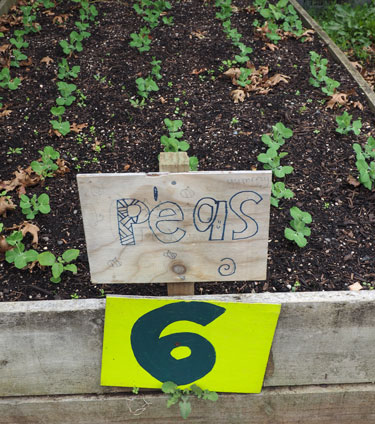A place to learn
Sue Linn takes a wander around the school gardens at Dawson Primary in Otara.
At Dawson Primary school there is a classroom dedicated to science and nature. Here, every child from new entrants to Year 6 spends an hour each week with specialist Science and Environment teacher Debbie Davies.
The day I visited Dawson Primary I found Debbie in action with a smiley crew of Year 4 students completing an exercise categorising materials into solids liquids and gases. Later that day she’s working with year six students learning about the structure of solids, liquids and gases. I don’t remember being introduced to such things before high school.
Debbie’s classroom is a vibrant spaced filled with life and creativity. She apologises for the mess. I only see colour and warmth and a whole lot of plant and animal life going on. We enter a special glowworm ‘cave’ she has created in one corner, shining little torches on various insects and plants.
I ask Debbie where she gets all her ideas from. She says the hardest part is slowing the flow. “They keep me awake at night so I sleep with a pad and pen by the bed” she confesses.
When the bell rings for morning tea, Debbie takes me through the school’s gardens. First, a board walk through native bush which ends with a butterfly garden. Then through a gate to a vast area of raised vege beds, compost heaps and worm farms.
The vege garden is between seasons but there is still plenty to supply the weekly cooking classes. Pears and apples hang from trees, there is a bounty of silverbeet, herbs and salad greens and they’re still harvesting the kumara they planted before the summer holidays. Through a locked gate we visit a ‘mini wetland’ with native plants and a pond alive with creatures.
In addition to her classroom lessons, Debbie spends three to four morning tea and lunchtime slots in the gardens each week with volunteer teams of enviro students. When weather permits, she takes the classroom lessons outdoors. “Some weeks I have every class outside. We take advantage of the summer weather as much as we can,” says Debbie. “We might be planting, collecting bugs, weeding, or collecting herbs, flax and flowers to dry or make potions with or to use for craft work. Sometimes we do bird watching or make bird feeders to hang in our trees. And we study the plants. Currently, some of my senior students are using iPads to research which native plant is which so we can establish signage for our native gardens.”
On Tuesdays and Wednesdays students join the school chef and parent volunteers for a 90 minute session of gardening, cooking and eating. Half the class are the designated gardeners for the session. They harvest the vegetables and deliver them to the kitchen. Then, while their classmates prepare the meal the gardeners return to the garden. When the meal is ready they all wash up and sit around set tables to enjoy what is often something new and interesting for lunch. “We grow everything from Jerusalem and Globe artichokes to Kale,” says Debbie. “We have found that if they have grown it, the children will eat it .”
In Debbie’s experience the five year olds are just as passionate as the senior students. “Perhaps more so when it comes to exploring in the worm farms! The hands on factor attracts all age groups.”
What does she think about the idea that gardening makes kids smarter? “Based on my own experience, and also from research that I have undertaken, I believe it's the ability to have hands-on experiences that relate directly to their own lives that enhances students' educational experiences. I have seen many students struggle to understand abstract mathematical concepts like length-times-width-times-height when they have no visual relationship to those factors. However, I have seen these same students using tape measures, working around the edges of raised gardens and involved in deep discussions with their peers in order to determine how many cubic metres of soil we need to get delivered to top the gardens up. Measuring 5 cm on a piece of paper can be meaningless at times, but marking that same measurement on a piece of dowelling in order to drill holes for seeds in the garden is a totally different thing as far as some students are concerned.”
Dawson School’s impressive garden and kitchen setup has a big reputation locally but it’s taken some passionate individuals strong community support to get to this stage.
“Prior to my joining Dawson Primary we had a teacher who was also passionate about gardening,” explains Debbie. “She entered some competitions (such as growing strawberries) and won enough money to start up six garden beds and establish some water tanks. After I joined the school we applied successfully for grants from Four Winds and Mazda, which helped to increase the number of gardens. Another teacher from our school gained funding from the Counties Manukau District Health Board which helped greatly with paths, gardening barns and tools and kitchen equipment. Planning advice was donated by OPUS and after we joined the Garden to Table Trust we had further access to advice and assistance with a garden specialist twice a week.”
Debbie says the school’s efforts to gain further funding to help maintain the programme are constant and they are fortunate to have a very supportive board of trustees who believe in the value of a kitchen garden programme for their students. “In addition we have been fortunate to have the assistance of several volunteer groups to help with physical work.” These supporters include BNZ Closed for Good, The Young Warriors, Kimberley Clark, and a local church group. They also have the support of the school’s families who help out at working bees.
When Debbie heads back to the classroom she assigns Year 4 Enviro team members , Selesa, Jacinta, Sela and Milika, to escort me for a photo trip around the garden. Their pride in their school and its gardens is plain to see as they give me lessons on pollination, predatory insects and worms.
Later that day the sign off at the end of my email from Debbie reads, “If a child can't learn the way we teach … maybe we should teach the way they learn.”

1-May-2017

Enviro team members Selesa, Jacinta, Sela and Milika

A boardwalk makes a safe easy passage through the vegetable gardens

Peas sown in autumn will be picked for the school kitchen in spring.

